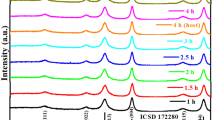Abstract
Cobalt-doped nanosized magnesium aluminate (Mg1−xCoxAl2O4) samples having different compositions (x = 0.2, 0.4, 0.6, 0.8, 1.0) were synthesized by a chemical co-precipitation method. All samples were characterized by means of x-ray diffraction (XRD), scanning electron microscopy, Fourier transform infrared spectroscopy, ultra violet–visible spectroscopy, photoluminescence and diffused reflectance spectroscopy. The results of XRD revealed that the samples were spinel single phase cubic close packed crystalline materials. The lattice constant and x-ray density were found to be affected by the ionic radii of the doped metal cations. Using the Debye–Scherrer formula, the calculated crystalline size was found to be Co2+ ion concentration-dependent and varied between 32 nm and 40 nm. Nano-dimensions and phase of the Mg1−xCoxAl2O4 samples were analyzed and the replacement of Mg2+ ions with Co2+ ions was confirmed by elemental analysis. Three strong absorption bands at 540 nm, 580 nm and 630 nm were observed for the doped samples which are attributed to the three spin-allowed 4T1g (4F) → 4T2g, 4A2g, 4T1g (4P) electronic transitions of Co2+ at tetrahedral lattice sites. Nanophosphors have optical properties different from bulk because of spatial confinement and non-radiative relaxation. Decreases in particle size can increase the surface area and the defects, which can in turn increase the luminescent efficiency to make it very useful for tunable laser operations, persistent phosphorescence, color centers, photoconductivity and luminescence for display technology. MgAl2O4 was doped with Co2+ ions using a co-precipitation method and the optical absorption studies revealed that there is a decrease of band gap due to the increase of Co2+ content. The emission intensity of this phosphor is observed at 449 nm with a sharp peak attributed to the smaller size of the particles and the homogeneity of the powder.
Similar content being viewed by others
References
J. Ahmed, M.Q. Awan, M.E. Mazhar, and M.N. Ashiq, Phys. B 406, 255 (2011).
V. Singh, R.P.S. Chakradhar, J.L. Rao, and D.K. Kim, J. Solid State Chem. 180, 2067 (2007).
I. Omkaram, G. Seeta Rama Raju, and S. Buddhudu, J. Phys. Chem. Solids 69, 2066 (2008).
H. Nakagawa, K. Ebisu, M. Zhang, and M. Kitaura, J. Lumin. 102–103, 590 (2003).
P.J. Deren, M. Malinowski, and W. Strek, J. Lumin. 68, 91 (1996).
A. Tomita, T. Sato, K. Tanaka, Y. Kawabe, M. Shirai, K. Tanaka, and E. Hanamura, J. Lumin. 109, 19 (2004).
J.F. Donegan, F.J. Bergin, and G.F. Imbush, J. Lumin. 31, 278 (1984).
M.M. Amini, M. Mirzaee, and N. Sepanj, Mater. Res. Bull. 42, 563 (2007).
M.J. Iqbal and B. Ismail, J. Alloys Compd. 504, 440 (2010).
E. Alagu Raja, S. Menon, B. Dhabekar, N.S. Rawat, and T.K. Gundu Rao, J. Lumin. 129, 829 (2009).
J. Guo, H. Lou, H. Zhao, Z. Wang, and X. Zheng, Mater. Lett. 58, 1922 (2004).
I. Omkaram, G.S.R. Raju, and S. Buddhudu, J. Phys. Chem. Sol. 69, 2066 (2008).
M.J. Iqbal and B. Kishwar, Mater. Res. Bull. 44, 763 (2009).
T.A. Bazilevskaya, V.T. Gritsyna, D.V. Orlinski, L.V. Udalova, and A.V. Voitsenya, J. Nucl. Mater. 253, 133 (1998).
R. Ianos, R. Laza˘u, and P. Barvinschi, Adv. Powder Technol. 22, 396 (2011).
I. Omkaram, and S. Buddhudu, Opt. Mater. 32, 8 (2009).
U.L. Stangar, B. Orel, and M. Krajnc, J. Sol Gel Sci. Technol. 26, 771 (2003).
M. Zayat and D. Levy, Chem. Mater. 12, 2765 (2000).
M. Dondi, T.S. Lyubenova, J.B. Carda, and M. Ocana, J. Am. Ceram. Soc. 92, 1979 (2009).
L.K.C. De Souza, J.R. Zamian, G.N.R. Filho, L.E.B. Soledade, I.M.G. Dos Santos, G. Souza, T. Scheller, R.S. Angelica, and C.E.F. Da Costa, Dyes Pigments 81, 190 (2009).
K.J. Kim, H.K. Kim, Y.R. Park, G.Y. Ahn, C.S. Kim, and J.Y. Park, Hyp. Int. 169, 1366 (2006).
A. Jouini, A. Yoshikwa, T. Fukuda, and G. Boulon, J. Cryst. Growth 293, 517 (2006).
P. Gluchoski, R. Pazik, and W.Strek Hreniak, J. Phys. Chem. 358, 53 (2009).
S.V. Motloung, F.B. Dejene, M.E. Sithole, L.F. Koao, O.M. Ntwaeaborwa, H.C. Swart, and T.E. Motaung, J. Electron. Mater. 45, 4796 (2016).
Acknowledgement
The services provided by Dr. Tajammul Hussain (Late) at National Center for Physics are strongly acknowledged by all the authors.
Author information
Authors and Affiliations
Corresponding author
Rights and permissions
About this article
Cite this article
Kanwal, K., Ismail, B., Rajani, K.S. et al. Effect of Co2+ Ions Doping on the Structural and Optical Properties of Magnesium Aluminate. J. Electron. Mater. 46, 4206–4213 (2017). https://doi.org/10.1007/s11664-017-5353-8
Received:
Accepted:
Published:
Issue Date:
DOI: https://doi.org/10.1007/s11664-017-5353-8



